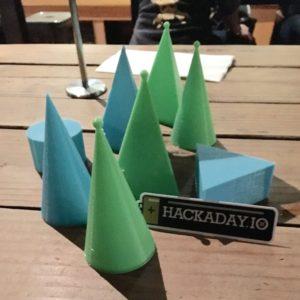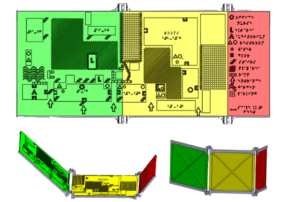3D printing technology has proven useful for a number of commercial and personal endeavors, but it has had an especially profound impact on those with various disabilities and impairments. For instance, across the world, 3D printing has become a go-to tool to help improve the livelihood of individuals suffering from blindness. The emerging technology has helped the visually impaired in a number of ways, from giving them better access to the world’s finest art to enhancing their educational experience.
Two Los Angeles-based teachers, Mike Cheverie and Lore Schindler, have recognized the immense value of 3D printing and became early adopters of the technology. Cheverie, a teacher of the visually impaired at Valley Academy of Arts and Sciences, and Schindler, a technology specialist for the visually impaired at the Los Angeles Unified School District, both started utilizing 3D printing to teach abstract math and scientific concepts to their students. Two years ago, these two educators were brought together by MIT alumna Joan Horvath and open-source 3D printer hacker Rich Cameron to host a 3D printing project with a group of students from the Pasadena City College.
With this project, the team of students decided to 3D print a tactile map of a school that contained a high number of visually impaired students. This type of map uses raised symbols, Braille, and structural outlines to help the blind students navigate through their school grounds. Though the project was ultimately a success, the group was forced to overcome a number of obstacles involving the mixture of physical and abstract information. For instance, when the team had to invent a symbol to show where a doorway was, they accidentally used the existing symbol for “ladies’ room”.
Due to the necessity of having both physical and abstract information on the 3D map model, the team had to come to a number of difficult decisions on what information they should include. If they labeled too much of the map with Braille and symbols, they would risk the map becoming completely unreadable. Still, the educators were able to mentor these students into creating a couple of viable 3D maps. During the two years following this project, mentors Horvath and Cameron have been working to give educators of the visually impaired access to these 3D printable designs, and founded Nonscriptum LLC in 2015.
 They soon realized, though, that the teachers didn’t have much time to learn CAD and create these assistive models on their own, even with access to a 3D printer. But, on the other hand, many students that were learning 3D printing and 3D design did have the time and resources to create 3D prints that were helpful to the visually impaired. And so, Horvath and Cameron decided to enter the 2016 Hackaday Prize competition to create this educational community on a worldwide scale. Their entry centers around a Google Group that allows educators of the visually impaired to request 3D models they wish they had access to.
They soon realized, though, that the teachers didn’t have much time to learn CAD and create these assistive models on their own, even with access to a 3D printer. But, on the other hand, many students that were learning 3D printing and 3D design did have the time and resources to create 3D prints that were helpful to the visually impaired. And so, Horvath and Cameron decided to enter the 2016 Hackaday Prize competition to create this educational community on a worldwide scale. Their entry centers around a Google Group that allows educators of the visually impaired to request 3D models they wish they had access to.
To show the potential value of their community, they fulfilled one teacher’s request to design objects with different geometric shapes. Each shape was hollow and had one open side, which would allow students to fill them with water and see that the volume was the same in each shape. Horvath and Cameron were also tasked with designing the shapes with removable lids, as well as blunting the sharp points of the shapes to ensure safe use for blind students. All in all, their open-source project has been a success thus far, and as of now has been downloaded around 729 times.
Their Hackaday entry was selected as semifinalist — a modular robot created for search a rescue missions took home the top prize — and this project has positive implications that reach far beyond the competition. Both Horvath and Cameron hope that their Google Group will become a catalyst for their style of collaborative learning between the student and teacher. Not only does their 3D printing-driven initiative aim to help the visually impaired and their teachers gain better access to educational tools, it also offers other students the opportunity to learn the true potential of 3D design and 3D printing technology. Discuss in the 3D Printed Educational Models forum at 3DPB.com.
Subscribe to Our Email Newsletter
Stay up-to-date on all the latest news from the 3D printing industry and receive information and offers from third party vendors.
You May Also Like
3D Printing Financials: Fathom Struggles in Financial Quicksand During Critical Transition
Facing a year of key transitions and financial pressures, Fathom (Nasdaq: FTHM) has filed its annual report for 2023 with the U.S. Securities and Exchange Commission (SEC). The document outlines...
Latest Earnings Overview for Australian 3D Printing Firms Titomic and AML3D
Australian 3D printing manufacturing firms Titomic (ASX: TTT) and AML3D (ASX: AL3) reported their financial results for the period from July to December 2023, marking the first half of their...
3D Printing Webinar and Event Roundup: April 7, 2024
Webinars and events in the 3D printing industry are picking back up this week! Sea-Air-Space is coming to Maryland, and SAE International is sponsoring a 3D Systems webinar about 3D...
3D Printing Financials: Unpacking Farsoon and BLT’s 2023 Performance
In the Chinese 3D printing industry, two companies, Farsoon (SHA: 688433) and Bright Laser Technologies, or BLT (SHA: 688333), have recently unveiled their full-year earnings for 2023. Farsoon reported increases...


































